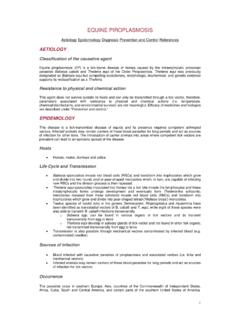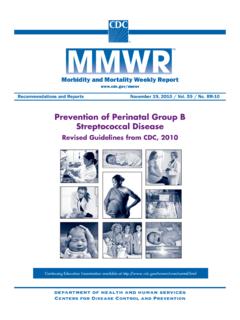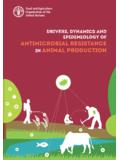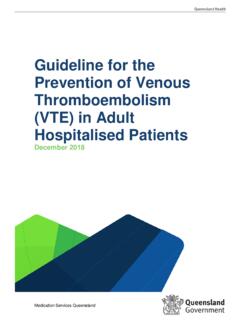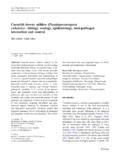Transcription of C. difficile Testing with Molecular or Nucleic Acid ...
1 A better way. C. difficile Testing with Molecular or Nucleic Acid Amplification Tests Frequently Asked Questions Q: Who should be tested for C. difficile ? A: Diagnostic Testing for C. difficile should be performed only in patients with clinically significant diarrhea (patients with 3 or more loose stools in 24 hours) who have risk factors for CDI such as recent exposure to antibiotics, older age, and/or duration of stay at a hospital or nursing Acceptable samples should be unformed stool specimens that take the shape of the container. Q: Do Molecular or Nucleic Acid Amplification Tests (NAAT) overdiagnose C. difficile ? A: Molecular tests/NAATs are designed to detect DNA from Clostridium difficile organisms capable of producing toxin (also referred to as toxigenic C.)
2 difficile ) found in stool. PCR is one type of NAAT. The sensitivity of detection of toxigenic C. difficile organism by GeneXpert has been reported to be 94 99%2-4 and correlated well with a clinical diagnosis of C. difficile infection (CDI).2 Commercially available Molecular assays are not designed to assess host response or to determine if the patient requires treatment, although they do provide valuable information to the physician when used in the context of other clinical features. In addition, 80 90% of samples tested for C. difficile are negative. Because they are very sensitive, Molecular tests can be used to rule out C. difficile in the majority of patients more confidently than with immunologic methods.
3 Thus, a rapid and sensitive Molecular test can help to avoid unnecessary empiric therapy that is often administered to patients during the time clinicians are waiting for lab results (as described below). Q: How do clinicians determine if a patient has C. difficile infection? A: The first step is to determine if the patient's sample contains toxigenic C. difficile . Patients positive for toxigenic C. difficile constitute an infection control risk, and can transmit disease to other ,6 Once a patient with toxigenic C. difficile has been identified and appropriate infection control measures have been implemented, the next step is to determine if the patient has CDI and requires treatment.
4 A number of features can be used to determine the presence of infection including the clinical picture (antibiotic history, frequency/severity of diarrhea) as well as other indicators of disease severity (for example, WBC count, creatinine level, albumin level, fever etc). Free toxin has also been evaluated as an indicator of ,7. Guidelines advise that since enzyme immunoassay (EIA) tests for toxin A and B are less sensitive than other methods, such as PCR, they are not recommended for standalone ,8 A recent study by Polage et al. showed that the toxin assay failed to detect toxin in 30% of PCR-positive samples, as detected by cell cytotoxin assay repeat In fact, among stool samples initially positive by PCR and negative for toxin that were sent for retesting (likely because the physician still suspected CDI), 21% of the toxin assays were positive upon retest.
5 In lieu of definitive measure of disease, clinicians must take into account the complete clinical picture. As a recent editorial stated, Regardless of which assay is used, it is best to remember to treat the patient, not the test. 9. PAGE 1 CEPHEID 0527-02. Frequently Asked Questions (continued). Q: Do all patients with CDI require treatment? A: Yes, all patients with CDI, including mild CDI, should be treated in accordance with SHEA and IDSA. Treatment strategies should be based on disease severity, history of prior CDI, and the individual patient's risk of Q: Are Molecular or PCR-based tests too sensitive? A: PCR-based assays are used to determine if the patient sample contains toxigenic C.
6 difficile and, consequently, whether that patient constitutes an infection control risk; in this case, a sensitive test is needed. In fact, a recent health economic analysis concluded that sensitive, on-demand PCR Testing is more cost-effective than other Testing approaches because it reduces the likelihood of infection transmission and associated infection-related A positive result from a PCR assay should not be the sole basis for determining if the patient requires treatment. The decision to administer antibiotic therapy should be based on disease severity, history of prior CDI, and the individual patient's risk of Q: Should toxin immunoassays be used to determine if a patient requires treatment?
7 A: Some published studies have shown that patients with toxin-positive stool samples had worse outcomes than patients with samples negative for ,7 However, another study showed that among PCR-positive samples, the outcomes of patients with toxin-positive stools and toxin-negative stools were Thus, the decision as to whether to use a toxin assay to decide on therapy will be institution specific. It is important to note that not all toxin assays perform the same and the performance of more commonly used rapid lateral-flow EIA toxin tests was not evaluated in the larger, published studies noted in the previous paragraph. Although toxin ELISA assays are more sensitive than their lateral-flow counterparts, they are very manual, require technical expertise and contain multiple incubation and wash steps.
8 They are best suited for batch Testing , which is likely to delay the time to result. Antigenic variation in the toxin proteins can affect performance of toxin immunoassays compared to Molecular methods; the latter are generally unaffected by toxin variation because they are designed to detect conserved regions of the toxin genes. It should be noted that studies performed at a single medical center may not include enough strain variation to see these effects. Finally, C. difficile toxins break down in stool over time13, so time spent in specimen transport and in waiting for batch analysis can affect performance. For these and other reasons, toxin immunoassays are not recommended for standalone use in the diagnosis of CDI.
9 Q: Should all patients with a positive PCR-based C. difficile test be treated? A: No, not all patients Testing positive for C. difficile with PCR-based assays should be treated. Only patients who meet the clinical criteria for CDI should be treated; patients who test positive by PCR who do not meet those criteria may be colonized. The decision to administer antibiotic therapy should be based on disease severity, history of prior CDI, and the individual patient's risk of Q: Is the use of Molecular assays associated with overtreatment? A: A recent study6 and accompanying editorial9 suggested that the use of Molecular tests for the diagnosis of CDI. was likely to result in overtreatment.
10 The same study showed that 32% of patients with stool samples negative for C. difficile by both PCR and toxin Testing received treatment. The fact that a third of patients negative for both tests received antibiotics speaks to the pervasive use of empiric therapy, regardless of the test results. In addition, the chance that a patient receives empiric therapy is likely to increase the longer it takes to obtain a test result. This underscores the need for a rapid test, like a PCR-based test, which can provide an accurate result in less than an hour. Having a negative test result by a more sensitive test should give treating physicians more confidence in making a decision to avoid unnecessary empiric therapy, especially in the absence of other risk factors.

